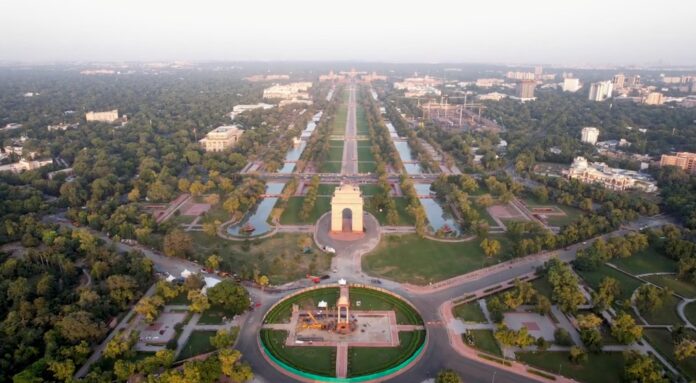The first stage of the controversial $1.8bn redevelopment of Delhi’s parliament complex is now complete, after the 3km-long Central Vista avenue opened to the public earlier this month. One of the largest outdoor public spaces in Delhi, it had been closed since February 2021.
During the opening ceremony, India’s prime minister Narendra Modi unveiled a 28-ft tall statue of Indian independence figure Subhas Chandra Bose near the India Gate memorial; at the same time it was announced that the ceremonial boulevard that runs through much of the complex would be renamed from “Rajpath” to “Kartavya” path, the Hindi word for “duty”. According to the prime minister’s website, the former site was “a symbol of slavery”. The redevelopment, and its accompanying rename, represents a “shift to public ownership and empowerment”, he says.
Next steps
Attention has now turned to what is left of the project, which was announced by Modi in late 2019. This includes a new parliament building to replace the one designed by the British architects Edwin Lutyens and Herbert Baker in 1927 during British rule of India. Designed by the Indian architect Bimal Patel, it is now “70% complete” and is set to open in November, the urban affairs minister Kaushal Kishore told members of parliament during a meeting in August. This new building will contain four galleries to hang Indian art that “reflect the national ethos”, an unidentified source tells the Indian Express. Of these works—a mix of portraits, illustrative art, installations, sculptures and decorative art—around 70% have been commissioned. Focused displays will feature art depicting tribal leaders, and the contribution of women to Indian independence.
Six granite statues of historic Indian figures will be installed. The building will also receive over a dozen intricately woven silk rugs from artisans working in Kashmir. The contested Himalayan mountain state was annexed in 2019 under Modi and recently faced one of the world’s longest-ever internet blackouts.
Meanwhile the prime minister’s residence is also undergoing a redesign, and will be opened in December, officials say.
Cultural spaces
The Central Vista redevelopment plans will rehouse two of the capital’s most prominent cultural institutions. The National Museum will move to a site currently occupied by the Cabinet Secretariat, the government’s administrative arm. The museum, which holds around 200,000 works of art spanning some 5,000 years, was opened in 1949. Its current premises is, according to plans on the government’s website, “nearing the end of its lifespan” and will be demolished to make way for a new building that will house all government ministries. Those close to the project estimate the completion date for this stage to be between 2024 to 2026, according to the Economic Times. This building will continue to house the National Archives of India, which has been on site since the 1990s, but the annexe that houses the archives will be razed and rebuilt.
Meanwhile, the Indira Gandhi National Centre for Arts, an autonomous government body comprising an art gallery, research facility and library that was opened in 1985, will move from its current location to Jamnagar House near India Gate. According to India’s former culture minister Prahlad Singh Patel, “an expansion of [the centre’s] role as a cultural space” is also being considered.

A statue placed atop the new parliament building has drawn criticism over its “aggressive” appearance. © Getty Images
Snarling critique
Modi’s grand redesign plans have drawn ire from his critics, who have described it as a gross mismanagement of funds, especially as its first stages coincided with a devastating wave of Covid-19 in India between March and July 2021 that paralysed the country.
Recently, the installation atop the parliament building of a 21-ft bronze sculpture of four lions has provoked criticism. The statue, based on a 3rd-century BC sandstone sculpture known as Lion Capital of Ashoka, a two-dimension version of which was made into India’s post-independence national emblem, has been termed “unnecessarily aggressive”. Jawhar Sircar, a politician in the Indian parliament’s upper house, termed them as “snarling”, while the Supreme Court lawyer Prashant Bhushan tweeted that “angry lions with bared fangs” reflected the current political climate. “This is Modi’s new India!” he said.

























